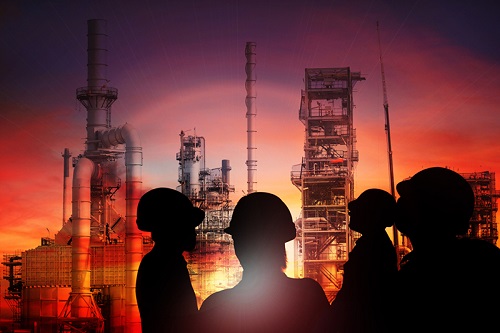A survey conducted by the Rand Corporation on working conditions in the U.S., found that nearly half of employees work in hazardous environments like refineries, drilling rigs, offshore platforms, mining operations, demolition sites, and chemical plants. In these settings, blast-resistant buildings and clothing can be valuable safety tools to protect workers. The following tips show advancements in blast-resistant technology and how it can reduce injuries and save lives.

1 Understand blast-resistant technology.
Blast-resistant technology is designed to protect people, equipment, and processes from explosions, fires, and toxic releases. Fire and blast resistant materials can be used to make doors, windows, curtains, and clothing. Spraying special substances on walls can also help keep broken shards and debris in place. Tightly woven fibers, like those in Kevlar or Aramid, can spread the force of a blast to reduce its impact. There are also new and emerging technologies for blast-resistant clothing like liquid body armor that makes Kevlar stronger, carbon nanotubes that are 60 times stronger than steel, and fibers, known as auxetic materials, that expand when stretched by the force of a blast.
2 Assess the risks.
Identify potential dangers in your workplace. Look for flammable materials, areas with high risks, or nearby industrial facilities. This will help you determine the level of protection needed and how to implement it. Here are some situations where blast-resistant buildings or clothing might be necessary:
- Previous incidents.
If there have been past explosions or accidents in your workplace or similar industries, investing in blast-resistant technology can help prevent future incidents and keep your employees safe. - High-risk locations.
If your workplace is in an area near chemical plants or refineries, using blast-resistant buildings can protect your employees from blasts and toxic materials. - Hazardous processes.
Industries that handle volatile chemicals or work with explosive materials may need blast-resistant buildings and clothing to minimize the risk of accidents and protect workers.
3 Work with experts.
Get help from professionals like structural engineers, architects, and security consultants who know about blast-resistant technology to find the best solutions for your workplace and employees. They can create custom designs that fit your operations, even in difficult or remote locations.
4 Strengthen buildings and use blast-resistant design principles.
Reinforce walls, roofs, and windows with materials like high-performance laminated glass, layered concrete, and steel. These materials can withstand explosions and reduce the risk of building collapse. Ensure proper ventilation.
5 Choose the right gear to protect yourself.
Make sure employees have personal protective equipment that can withstand heat, flames, and flying objects. This gear should meet industry standards and be checked regularly for damage. Look into new technologies for fire-resistant fabrics and fibers that offer extra protection against blasts. Make sure equipment fits well, feels good, and is right for the task.
6 Educate and train employees.
Educate and train employees on the risks of explosions and the proper use of blast-resistant clothing and equipment. Conduct drills and exercises to familiarize them with safe zones and emergency procedures. Review evacuation routes, assembly points, and communication systems. Foster a safety culture by encouraging a proactive safety mindset among employees, promoting the reporting of potential hazards and near misses, and improving safety practices continuously.
7 Comply with guidelines and standards.
Employers need to stay updated with the latest industry standards and guidelines. While the Occupational Safety and Health Administration (OSHA) does not have specific standards solely dedicated to blast-resistant buildings and clothing, the following standards may apply: General Duty Clause, Process Safety Management of Highly Hazardous Chemicals standard, Personal Protective Equipment standards, and construction standards.
In addition, the American Petroleum Institute (API) provides recommended practices (RP) for the oil and gas industry. API RP 753 addresses permanent buildings near process plants, while API RP 756 focuses on portable buildings. Other industry guidelines from organizations like the American Society of Civil Engineers (ASCE), American Society for Testing and Materials (ASTM), National Fire Protection Association (NFPA), International Organization for Standardization (ISO), and others may apply. These standards cover designing blast-resistant structures, evaluating blast-resistant materials, and ensuring protective clothing performance.
Familiarize yourself with these standards and guidelines, and create measures to prevent or mitigate the risks. By complying, you can enhance worker safety and create a secure working environment in high-risk industries.
If your company would like free, confidential in-person or onsite assistance to ensure you are complying with OSHA standards, contact one of DWC’s safety and health professionals with the Texas Occupational Safety and Health Consultation (OSHCON) Program. Consultants are available at 800-242-7031, option 2, or OSHCON@tdi.texas.gov. For more information, visit www.txoshcon.com.
